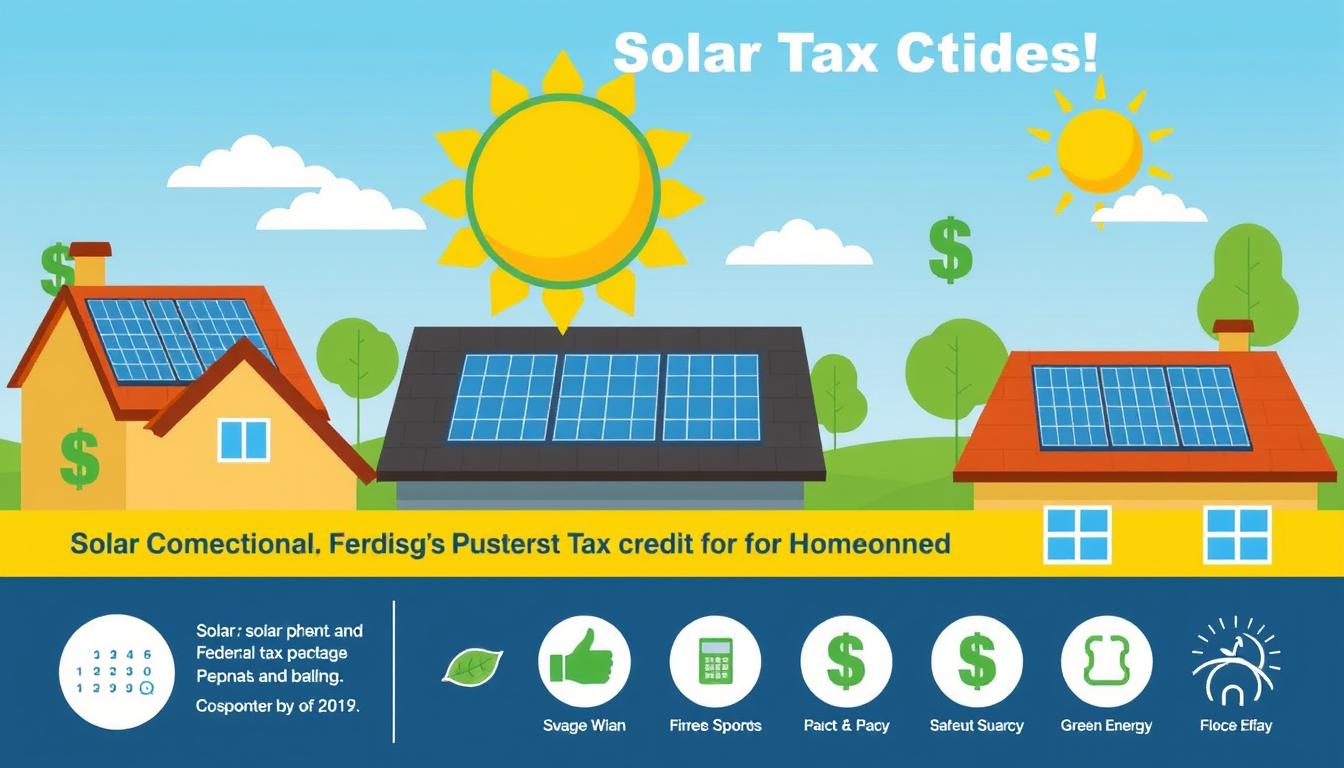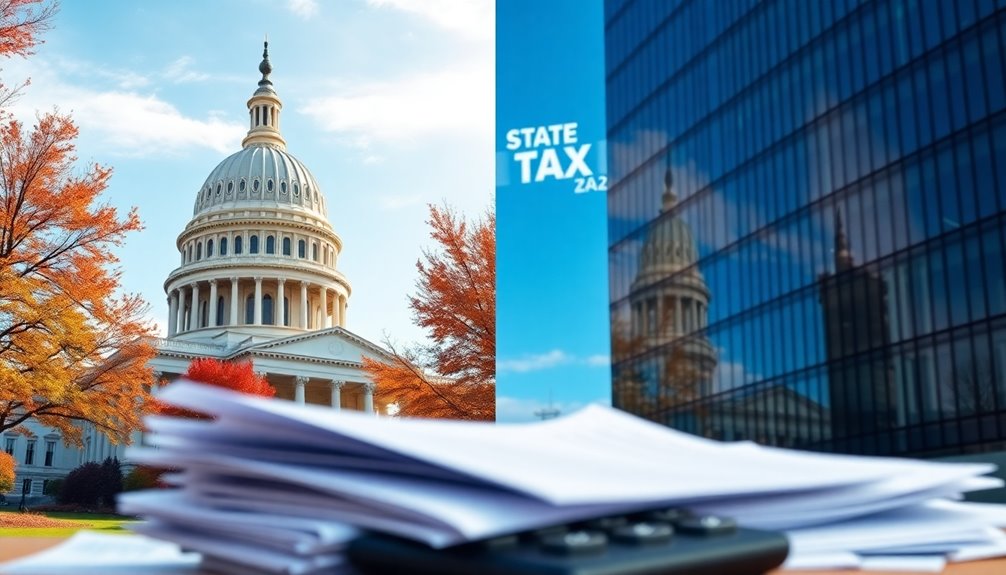Did you know that installing solar systems lets homeowners enjoy a tax credit now increased to 30% until 2032? This shift towards solar not only benefits the planet but also cuts down on your energy expenses. This guide will help you grasp everything about the federal solar tax credit12.
Knowing the details and opportunities of this program is crucial. It allows you to fully utilize this valuable incentive when you invest in solar energy.
Key Takeaways
- The federal solar tax credit is currently 30% for systems installed from 2022 to 2032.
- Tax credits are available for a variety of costs associated with solar installation.
- There is no maximum amount that can be claimed for the solar tax credit.
- Staying updated on installation deadlines can maximize your benefits.
- Utility rebates do not reduce your federal tax credit claims.
Understanding the Federal Solar Tax Credit
The federal solar energy credit, also known as the residential solar tax credit, is a great way for homeowners to lower the price of adding solar panels. You can get back 30% of your solar system’s cost on your taxes. This deal is good through 2032, thanks to the Inflation Reduction Act passed in August 20223. It helps with the costs of installation, labor, permits, and inspection fees3
Starting in 2024, this awesome federal solar energy credit lasts for systems set up until the end of 2034. This extension lets more homeowners save with solar energy4. When you switch to solar, you could save around $9,716 on average for an 11 kW system5. Plus, there are no income limits or caps on what you can claim with the Investment Tax Credit (ITC). This makes it available to many people, no matter their income4.
For the residential solar tax credit to work in your favor, you need to buy your solar system or finance it with a loan. Leases or Power Purchase Agreements (PPAs) won’t qualify4. Also, this tax credit lets you move any leftover balance to the next year. This encourages planning your finances for the future4.
What Is a Tax Credit?
A tax credit cuts down the amount of money you owe in taxes, dollar by dollar. So, if you get a $1,000 federal tax credit, it means you pay $1,000 less in taxes. This makes it better than tax deductions, which only reduce your taxable income, not the actual taxes owed.
The Federal Solar Tax Credit stands out as a key tax credit. It lets homeowners deduct up to 30% of the cost of installing solar panels, with no income limits. This move, aimed at boosting green energy, helps people save a lot on taxes. For example, the average solar tax credit claim is about $7,500, showing how valuable it is for homeowners67.

The solar tax credit offers a chance to save on taxes until 2034 if you invest in solar energy6. Knowing about this credit can guide homeowners to make smart choices about green investments. These choices help the planet and improve your finances.
| Year | Tax Credit Percentage | Notes |
|---|---|---|
| 2023 | 30% | Optimal time to invest for max savings |
| 2032 | 26% | Reduction begins |
| 2034 | 22% | Final percentage before expiration |
Understanding tax credits means you can use them to your advantage. This could lead to big tax savings and support for clean energy.
“Understanding tax credits can greatly impact your financial strategy, especially regarding renewable energy investments.”
Homeowner’s Guide to the Federal Tax Credit for Solar Photovoltaics
As a homeowner looking into solar energy, it’s key to understand your eligibility for the federal tax credit. This tax credit offers a big incentive, covering 30% of your solar PV system’s total cost. This includes the price for installing and the sales tax on components8. This opportunity is available until 2033. After that, the credit drops to 26% in 2034 and to 22% in 20358. To be eligible, your solar system must be set up within these dates. You also need to own the system, whether it’s connected to the grid or not.

Many homeowners see a return on their solar investment in 7 to 12 years. They also get a 30-year warranty for service and maintenance8. You can apply this eligibility to systems at vacation homes and secondary properties too. This shows how broad this credit is8. Even with different state rules, like Maine’s tax exemption for renewable equipment, check your eligibility. It’s based on how and when your system was installed and the type of roofing material8.
| Eligibility Criteria | Description |
|---|---|
| System Ownership | You must own the solar PV system installed on your property. |
| Installation Timeframe | Systems installed by 2033 will qualify for a 30% tax credit. |
| Type of Systems | Both grid-tied and off-grid solar systems are eligible. |
| Additional Costs | Installation labor and electrical upgrades are covered. |
| Property Types | Eligible systems include those on primary, vacation, or secondary homes. |
Considering these factors will help you understand the tax credit process. It lets you save money and embrace solar energy solutions more fully.
“Solar energy provides not only environmental benefits but also financial incentives for homeowners.”
How the Federal Solar Tax Credit Works
This section talks about the federal solar tax credit, what it is, who can get it, and what benefits it offers. Knowing about the solar tax credit helps homeowners decide on getting solar panels.
Tax Credit Amount Details
The federal solar tax credit is also known as the ITC. It lets taxpayers deduct 30% of their solar costs from their taxes until 2033. Then, it drops to 26% in 203410. There’s no limit to how much you can claim, meaning you can save a lot on your taxes5. For example, if your solar setup costs $32,386, using this tax credit could save you roughly $9,716 on average5.
Eligibility Requirements
To get this tax credit, there are certain rules you need to follow. You must own the solar system; rented systems or those under power purchase agreements don’t count10. Your solar setup must be put in place between January 1, 2006, and December 31, 20345. If you’re applying the tax credit between 2022 and 2032, the solar system can be for your main home or a vacation home, making it more beneficial for various installations2. Also, keep all receipts related to your solar project for when you file your taxes10.
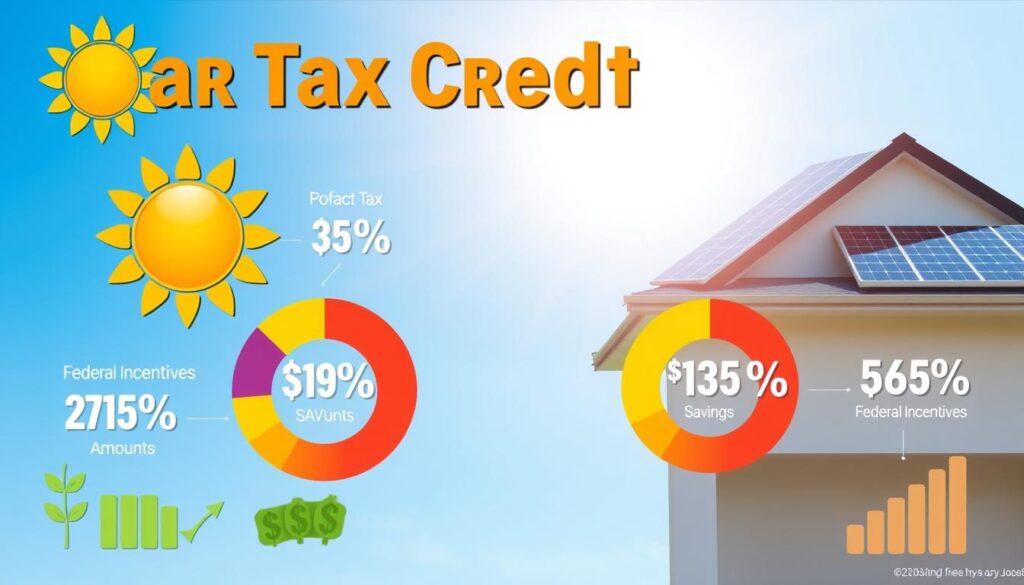
What Expenses Are Covered by the Tax Credit?
If you’re thinking about the federal solar tax credit, you need to know which expenses count. This program lets you get a 30% tax credit on your solar setup costs. This includes a range of expenses. Knowing what’s covered can help you save a lot when you file your taxes.
Eligible Equipment and Installation Costs
Solar equipment like electric panels and energy storage devices are included. The costs for these items, plus the sales tax on installation, are also covered. For example, a $20,000 solar system could get you a $6,000 tax credit. This lowers your costs a lot11. That’s why it’s important to keep track of all expenses. You need them to fully benefit from your tax credit.
Labor and Permitting Fees
Labor costs for installation are also eligible. This includes preparing the site, assembling, and connecting everything to your house12. Costs for permits from your local area can be included too. These savings add up, and the best part is, there’s no maximum amount for the tax credit5. So, make sure to keep good records of these expenses to get the most from the tax credit.
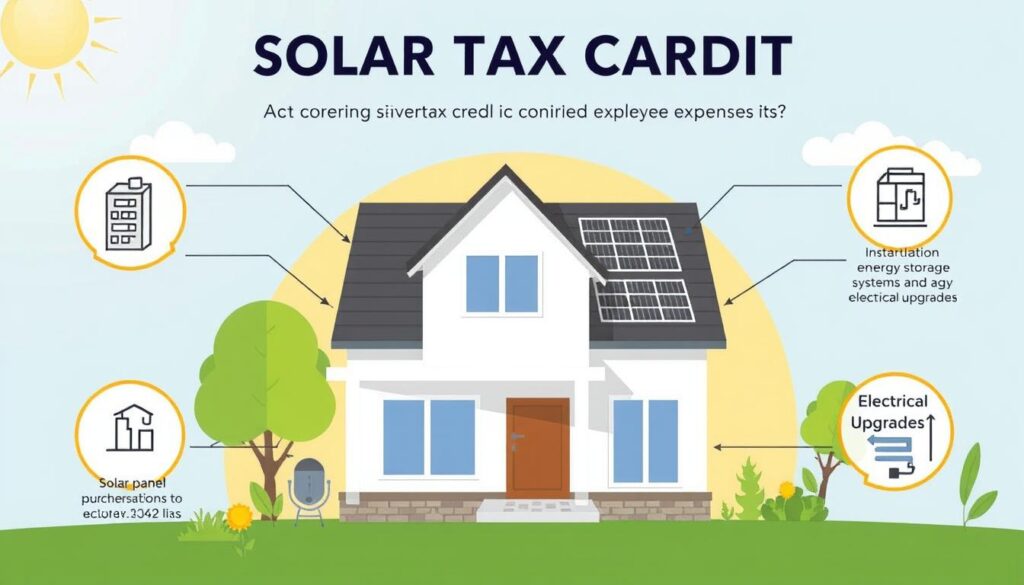
Am I Eligible for the Federal Solar Tax Credit?
To see if you can get the federal solar tax credit, you need to know a few key things. This credit lets you deduct a big part of your solar installation costs. This makes going solar more budget-friendly.
Ownership and Installation Dates
First off, you need to own your solar system to get the credit. It must be set up between January 1, 2006, and December 31, 2023. Right now, you can get back 30% of your costs as a tax credit for systems put in place by 2022. But this will drop to 26% in 2033 and to 22% in 203412.
There’s no limit to the money you can save, helping homeowners save a lot13. Also, your system must be installed at your main or second home in the U.S. This is crucial to know.
Residency Requirements
Your solar setup must be at a home you use. This rule covers both your main and second homes. It gives homeowners more choices. If you’re looking at a solar project not on your property, the rules might be different. Make sure your solar system meets these living area rules to fully enjoy the tax credit benefits.

Getting to know these points helps you figure out if you can get the federal solar tax credit5.
Other Incentives That Can Affect Your Tax Credit
Getting to know the different incentives can really help you save more with the federal solar tax credit. Things like rebates from utility companies and state tax credits can lower your costs. This means you could get a bigger tax break.
Utility Rebate Considerations
Rebates from utility companies are important for those installing solar panels. They help pay for part of the setup. You can then get a larger federal tax credit on the costs left. For example, a $1,000 rebate from your utility lowers your project costs. You calculate the tax credit after this deduction. Using these rebates can mean paying less yourself and getting more from federal benefits12.
State and Local Incentives
There are also perks from state and local governments. Maryland, for instance, offers a $1,000 grant for certain systems. Places like Prince George’s give up to $5,000 for solar work14. With PACE, you can pay over time which helps with budgeting14. Adding these to federal benefits ups your total savings. Many options available make solar power a solid choice.
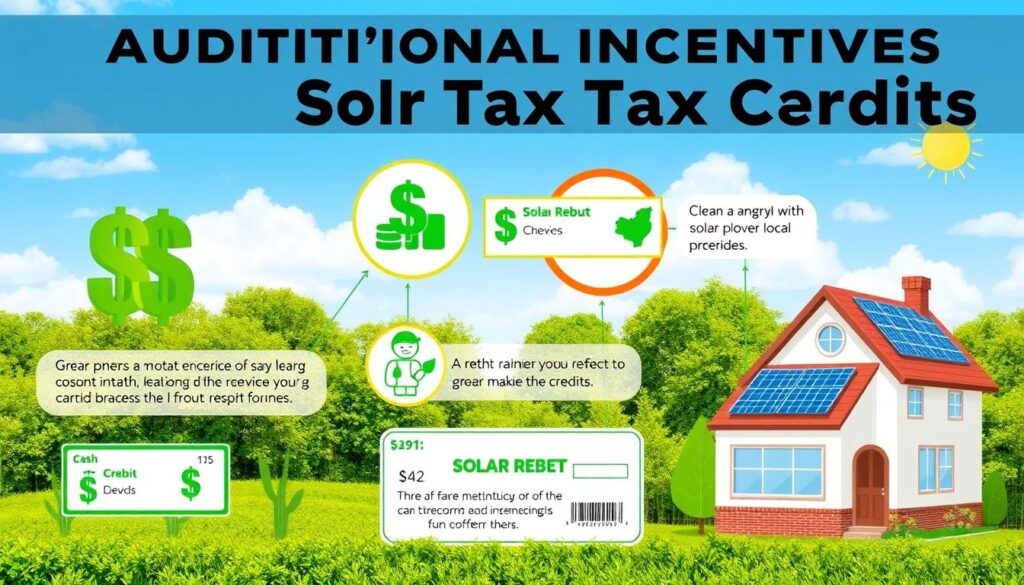
| Type of Incentive | Details |
|---|---|
| Utility Rebates | Often provided by local utility companies, these rebates can lower the installation costs. |
| State Tax Credits | Varies by state; often involves direct credits that reduce tax liability. |
| PAC Financing | Enables financing for solar installations through property taxes over 10-20 years. |
| Community Solar Programs | Allows households to subscribe to shared solar farms, yielding utility credits from energy produced. |
Calculating Your Tax Credit Savings
Getting the hang of the federal solar tax credit is key to boost your savings. Homeowners get to cut a good chunk of their solar setup costs from their federal taxes. When figuring out your savings, look at the cost of installation and the claiming period for the credit.
Practical Examples of Savings
Now, let’s dive into some real-life savings with the tax credit:
| Installation Cost | Tax Credit Percentage | Tax Credit Amount |
|---|---|---|
| $20,000 | 30% | $6,000 |
| $15,000 | 30% | $4,500 |
| $10,000 | 26% | $2,600 |
| $12,000 | 26% | $3,120 |
On average, choosing to claim the tax credit lets homeowners save an extra $9,7165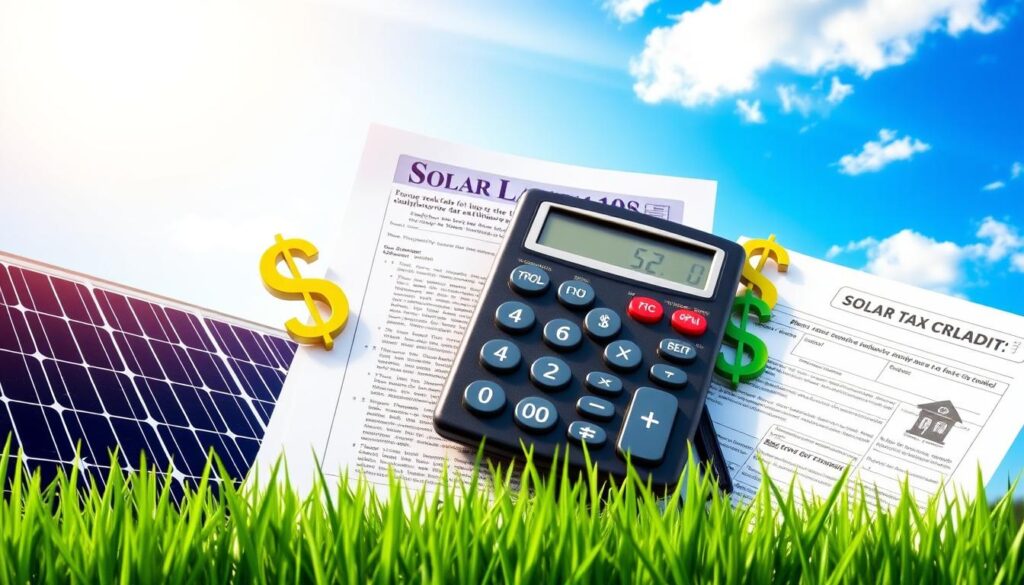
Impact on Your Tax Liability
Your tax reduction depends on your spending and tax situation. With the solar tax credit at 30%, a $20,000 installation lowers your taxes by $6,0003. The chance to invest is now, with the tax credit running through 2032. State or utility financial perks usually don’t change your federal credit eligibility.
Mixing local rebates with the federal credit ups your savings53. This pushes more homeowners towards solar energy.
How to Claim the Federal Solar Tax Credit
The process to claim your solar tax credit is easy and doable. Just follow a few steps to make sure you get the most out of the Federal Solar Tax Credit. First, check if you are eligible for the credit. You need to fill out IRS Form 5695, where you’ll list your installation costs and figure out your claim amount.
Filing Process Overview
Start by collecting all documents related to your solar expenses. This includes all invoices and receipts showing what you spent. The Federal Solar Tax Credit lets you claim up to 30% of your solar system’s costs. This can really reduce how much tax you owe. For example, if you spent $20,000 on installation, you might claim $6,000 on your taxes16. Then, it’s time to fill in the needed IRS forms carefully.
IRS Form Instructions
On IRS Form 5695, you’ll detail your costs for the solar energy system. You must accurately calculate 30% of your total expenses to find out the credit value17. After that, transfer this data to Schedule 3 and onto your Form 1040. This step links your credit to your overall tax return. If your tax owed is less than your savings from the ITC, you can carry over leftover credits16. It might be wise to talk with a tax professional to get through this process smoothly and get the most benefits.

Important Dates and Deadlines
Knowing key deadlines helps you get the most from the solar tax credit. This part explains the installation and tax filing timelines for solar systems. By knowing these timelines, you can avoid missing financial benefits.
Installation Timeline Considerations
Your solar installation needs to be done by certain dates to get the tax credit. For systems ready in 2022 or after, starting construction before 2033, you get a 30% tax credit18. Also, if you began building before January 31, 2023, you must meet specific labor rules to qualify for full credits18. Knowing these dates helps plan your solar project.
Tax Filing Year Points
Tax filing deadlines are key in getting solar tax breaks. Homeowners can cut their taxes by 30% of the cost to install solar panels, thanks to the Residential Clean Energy Credit19. For systems finished between 2022 and 2032, you’ll get a 30% credit. This drops to 26% in 2033, and 22% in 203419. If your tax due is less than your credit, you can use the rest next year, maximizing your solar investment19.
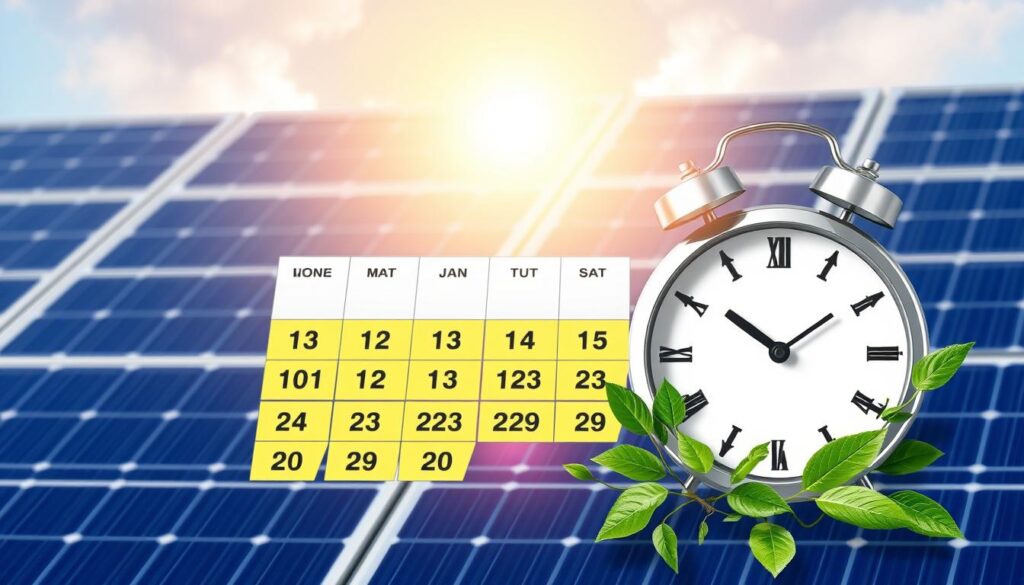
| Year | Tax Credit Percentage | Key Deadlines |
|---|---|---|
| 2022-2032 | 30% | Installation must be completed by December 31 of each year |
| 2033 | 26% | Installation must be completed by December 31 |
| 2034 | 22% | Installation must be completed by December 31 |
Focusing on these timelines and rules, you can smoothly go through installation and tax filing. This ensures you fully benefit from your solar venture1819.
Maximizing Your Savings Beyond the Tax Credit
Investing in solar energy brings Federal Solar Investment Tax Credit benefits. It also leads to energy savings and additional financial incentives. Homeowners across the country see benefits, cutting down long-term utility bills.
In Arizona, there’s a 25% Residential Solar Tax Credit. This is on top of a 30% Federal credit. Such credits offer great solar energy benefits until 203220. Homeowners also enjoy property and sales tax perks, enhancing solar’s appeal20.

Various states have net billing programs for solar homeowners. This lets them earn credits for extra energy produced. For example, Arizona’s Mohave Electric Cooperative runs a SunWatts Program, boosting solar incentives20.
Solar is now the cheapest form of new electricity. It’s leading in renewable energy investments21. With solar supporting over 22 million U.S. homes last year, shifting to renewable energy is key21. Plus, 25 states offer sales tax exemptions for solar systems, making solar more attractive21.
This showcases a strong support system for solar panel setups. Local and state policies aim to grow sustainable energy use. By using these benefits, you can increase your savings and enjoy all solar energy benefits.
| State | Residential Solar Tax Credit | Property Tax Exemption | Sales Tax Exemption | Net Billing Programs Available |
|---|---|---|---|---|
| Arizona | 25% | Yes | 5.6% | Yes |
| California | Varies | Yes | Yes | Yes |
| New York | Varies | Yes | Exempt | Yes |
With solar loans, leases, and agreements, setting up solar fits your budget. Taking these steps enhances your savings and supports renewable energy. It also makes your home more efficient2021.
Common Misconceptions About the Solar Tax Credit
Many homeowners are unsure about the solar tax credit benefits and requirements due to misinformation. A common myth is the belief that only homeowners can benefit from it. In truth, businesses can also claim a tax credit of up to 30% for solar panel installations until 2033. After that, the credit reduces22.
Some think solar panels don’t work well in bad weather. But solar panels still generate power on cloudy or rainy days. However, they might be less effective in very hot climates23. Also, the idea that solar systems are too pricey for average folks isn’t true. Residential solar systems cost between $15,000 and $35,000. Tax incentives can greatly reduce these costs23.
It’s also wrongly assumed that only new homes can have solar equipment. In fact, many existing homes can add solar technology. This is possible if skilled professionals do the installation to avoid roof damage24. The value of community solar programs is often missed. These programs let renters and apartment dwellers enjoy solar benefits by using shared solar arrays. This helps spread out the costs effectively.
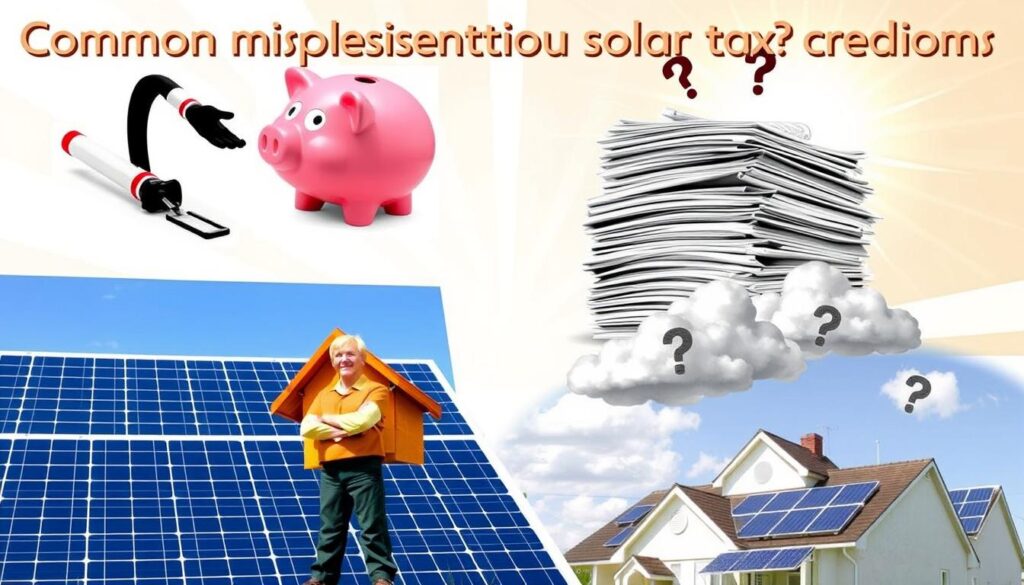
Staying Informed: Resources and Updates
Regulations are always changing, so using reliable solar tax credit resources is key. Since 2008, the U.S. has seen a huge increase in solar panel installations. This makes the solar industry a place filled with new chances and information25. By keeping up with updates from the government and trusted solar energy groups, you can stay ahead.
The Department of Energy and local agencies share news about grants and incentives. The Solar Investment Tax Credit (ITC) gives a 26% tax credit for buying a solar energy system. It’s important to know about any changes to these benefits25. Joining online solar energy communities helps you keep up with the latest trends and improvements.
Homeowners can often get a 30% credit for certain solar system costs for their U.S. homes. This shows how crucial it is to monitor these solar tax credit resources26. Regular updates from trusted sources can help you get the most from your solar investment.

Conclusion
Understanding the solar tax credit is key for homeowners looking into solar energy. This federal incentive lets you deduct a large part of your solar PV system’s cost. Installing it by December 31, 203427 makes it a wise economic decision. It offers long-term savings and supports a greener future.
This benefit covers many expenses including solar panels and installation. It’s within reach for lots of homeowners27. Working with reputable firms like Rayzon Solar guarantees quality equipment and advice. This ensures your solar investment pays off well over time.
The federal solar tax credit doesn’t just offer savings. It’s a crucial move towards renewable energy. By exploring these incentives, you improve your finances and join the clean energy movement28.
FAQ
What is the Federal Solar Tax Credit?
Who is eligible for the solar tax credit?
What expenses can I claim for the solar tax credit?
How does the tax credit work compared to tax deductions?
FAQ
What is the Federal Solar Tax Credit?
The Federal Solar Tax Credit is also called the Residential Clean Energy Credit. It gives homeowners a chance to claim a percentage of their solar system’s cost as a tax credit. This applies to systems set up from 2022 to 2032, giving a 30% credit.
Who is eligible for the solar tax credit?
If you own a solar PV system, have it at your main or secondary home, and it’s working during the tax year you’re claiming, you’re eligible.
What expenses can I claim for the solar tax credit?
You can claim costs for solar panels, installation, permits, and equipment like inverters. Batteries for energy storage may also qualify.
How does the tax credit work compared to tax deductions?
A tax credit directly lowers your tax bill. If you owe
FAQ
What is the Federal Solar Tax Credit?
The Federal Solar Tax Credit is also called the Residential Clean Energy Credit. It gives homeowners a chance to claim a percentage of their solar system’s cost as a tax credit. This applies to systems set up from 2022 to 2032, giving a 30% credit.
Who is eligible for the solar tax credit?
If you own a solar PV system, have it at your main or secondary home, and it’s working during the tax year you’re claiming, you’re eligible.
What expenses can I claim for the solar tax credit?
You can claim costs for solar panels, installation, permits, and equipment like inverters. Batteries for energy storage may also qualify.
How does the tax credit work compared to tax deductions?
A tax credit directly lowers your tax bill. If you owe $1,000 in taxes and get a $1,000 credit, you pay nothing. Tax deductions lower your income that can be taxed, which saves you money based on your tax bracket.
Are there any state incentives that I should consider?
Absolutely, many states have extra offers to reduce solar costs before the federal credit. Look for state credits, utility rebates, and local solar promotions.
How can I calculate my potential tax credit savings?
Calculate your savings by multiplying your solar installation’s total cost by 30% (for installations from 2022 to 2032). For instance, a $20,000 installation gives you a $6,000 credit.
What is the process for claiming the solar tax credit?
Claim your credit using IRS Form 5696 when filing federal taxes. Report your solar system’s cost and calculate the credit from these numbers.
Are there important deadlines I need to keep in mind?
Your solar project must be finished in the tax year you’re claiming. Also, file your taxes on time to secure your savings.
What are some common misconceptions about the solar tax credit?
Some think you need to live in your house all the time to get the credit. Or that tax credits work like rebates. It’s key to know credits cut down what you owe in taxes. And, you can get the credit even with a community solar project.
Where can I find reliable information on solar tax credits and updates?
For accurate updates on the Federal Solar Tax Credit, check IRS and Energy.gov. You can also consult trusted solar industry groups for recent news and guidance.
,000 in taxes and get a
FAQ
What is the Federal Solar Tax Credit?
The Federal Solar Tax Credit is also called the Residential Clean Energy Credit. It gives homeowners a chance to claim a percentage of their solar system’s cost as a tax credit. This applies to systems set up from 2022 to 2032, giving a 30% credit.
Who is eligible for the solar tax credit?
If you own a solar PV system, have it at your main or secondary home, and it’s working during the tax year you’re claiming, you’re eligible.
What expenses can I claim for the solar tax credit?
You can claim costs for solar panels, installation, permits, and equipment like inverters. Batteries for energy storage may also qualify.
How does the tax credit work compared to tax deductions?
A tax credit directly lowers your tax bill. If you owe $1,000 in taxes and get a $1,000 credit, you pay nothing. Tax deductions lower your income that can be taxed, which saves you money based on your tax bracket.
Are there any state incentives that I should consider?
Absolutely, many states have extra offers to reduce solar costs before the federal credit. Look for state credits, utility rebates, and local solar promotions.
How can I calculate my potential tax credit savings?
Calculate your savings by multiplying your solar installation’s total cost by 30% (for installations from 2022 to 2032). For instance, a $20,000 installation gives you a $6,000 credit.
What is the process for claiming the solar tax credit?
Claim your credit using IRS Form 5696 when filing federal taxes. Report your solar system’s cost and calculate the credit from these numbers.
Are there important deadlines I need to keep in mind?
Your solar project must be finished in the tax year you’re claiming. Also, file your taxes on time to secure your savings.
What are some common misconceptions about the solar tax credit?
Some think you need to live in your house all the time to get the credit. Or that tax credits work like rebates. It’s key to know credits cut down what you owe in taxes. And, you can get the credit even with a community solar project.
Where can I find reliable information on solar tax credits and updates?
For accurate updates on the Federal Solar Tax Credit, check IRS and Energy.gov. You can also consult trusted solar industry groups for recent news and guidance.
,000 credit, you pay nothing. Tax deductions lower your income that can be taxed, which saves you money based on your tax bracket.
Are there any state incentives that I should consider?
Absolutely, many states have extra offers to reduce solar costs before the federal credit. Look for state credits, utility rebates, and local solar promotions.
How can I calculate my potential tax credit savings?
Calculate your savings by multiplying your solar installation’s total cost by 30% (for installations from 2022 to 2032). For instance, a ,000 installation gives you a ,000 credit.
What is the process for claiming the solar tax credit?
Claim your credit using IRS Form 5696 when filing federal taxes. Report your solar system’s cost and calculate the credit from these numbers.
Are there important deadlines I need to keep in mind?
Your solar project must be finished in the tax year you’re claiming. Also, file your taxes on time to secure your savings.
What are some common misconceptions about the solar tax credit?
Some think you need to live in your house all the time to get the credit. Or that tax credits work like rebates. It’s key to know credits cut down what you owe in taxes. And, you can get the credit even with a community solar project.
Where can I find reliable information on solar tax credits and updates?
For accurate updates on the Federal Solar Tax Credit, check IRS and Energy.gov. You can also consult trusted solar industry groups for recent news and guidance.
FAQ
What is the Federal Solar Tax Credit?
The Federal Solar Tax Credit is also called the Residential Clean Energy Credit. It gives homeowners a chance to claim a percentage of their solar system’s cost as a tax credit. This applies to systems set up from 2022 to 2032, giving a 30% credit.
Who is eligible for the solar tax credit?
If you own a solar PV system, have it at your main or secondary home, and it’s working during the tax year you’re claiming, you’re eligible.
What expenses can I claim for the solar tax credit?
You can claim costs for solar panels, installation, permits, and equipment like inverters. Batteries for energy storage may also qualify.
How does the tax credit work compared to tax deductions?
A tax credit directly lowers your tax bill. If you owe
FAQ
What is the Federal Solar Tax Credit?
The Federal Solar Tax Credit is also called the Residential Clean Energy Credit. It gives homeowners a chance to claim a percentage of their solar system’s cost as a tax credit. This applies to systems set up from 2022 to 2032, giving a 30% credit.
Who is eligible for the solar tax credit?
If you own a solar PV system, have it at your main or secondary home, and it’s working during the tax year you’re claiming, you’re eligible.
What expenses can I claim for the solar tax credit?
You can claim costs for solar panels, installation, permits, and equipment like inverters. Batteries for energy storage may also qualify.
How does the tax credit work compared to tax deductions?
A tax credit directly lowers your tax bill. If you owe $1,000 in taxes and get a $1,000 credit, you pay nothing. Tax deductions lower your income that can be taxed, which saves you money based on your tax bracket.
Are there any state incentives that I should consider?
Absolutely, many states have extra offers to reduce solar costs before the federal credit. Look for state credits, utility rebates, and local solar promotions.
How can I calculate my potential tax credit savings?
Calculate your savings by multiplying your solar installation’s total cost by 30% (for installations from 2022 to 2032). For instance, a $20,000 installation gives you a $6,000 credit.
What is the process for claiming the solar tax credit?
Claim your credit using IRS Form 5696 when filing federal taxes. Report your solar system’s cost and calculate the credit from these numbers.
Are there important deadlines I need to keep in mind?
Your solar project must be finished in the tax year you’re claiming. Also, file your taxes on time to secure your savings.
What are some common misconceptions about the solar tax credit?
Some think you need to live in your house all the time to get the credit. Or that tax credits work like rebates. It’s key to know credits cut down what you owe in taxes. And, you can get the credit even with a community solar project.
Where can I find reliable information on solar tax credits and updates?
For accurate updates on the Federal Solar Tax Credit, check IRS and Energy.gov. You can also consult trusted solar industry groups for recent news and guidance.
,000 in taxes and get a
FAQ
What is the Federal Solar Tax Credit?
The Federal Solar Tax Credit is also called the Residential Clean Energy Credit. It gives homeowners a chance to claim a percentage of their solar system’s cost as a tax credit. This applies to systems set up from 2022 to 2032, giving a 30% credit.
Who is eligible for the solar tax credit?
If you own a solar PV system, have it at your main or secondary home, and it’s working during the tax year you’re claiming, you’re eligible.
What expenses can I claim for the solar tax credit?
You can claim costs for solar panels, installation, permits, and equipment like inverters. Batteries for energy storage may also qualify.
How does the tax credit work compared to tax deductions?
A tax credit directly lowers your tax bill. If you owe $1,000 in taxes and get a $1,000 credit, you pay nothing. Tax deductions lower your income that can be taxed, which saves you money based on your tax bracket.
Are there any state incentives that I should consider?
Absolutely, many states have extra offers to reduce solar costs before the federal credit. Look for state credits, utility rebates, and local solar promotions.
How can I calculate my potential tax credit savings?
Calculate your savings by multiplying your solar installation’s total cost by 30% (for installations from 2022 to 2032). For instance, a $20,000 installation gives you a $6,000 credit.
What is the process for claiming the solar tax credit?
Claim your credit using IRS Form 5696 when filing federal taxes. Report your solar system’s cost and calculate the credit from these numbers.
Are there important deadlines I need to keep in mind?
Your solar project must be finished in the tax year you’re claiming. Also, file your taxes on time to secure your savings.
What are some common misconceptions about the solar tax credit?
Some think you need to live in your house all the time to get the credit. Or that tax credits work like rebates. It’s key to know credits cut down what you owe in taxes. And, you can get the credit even with a community solar project.
Where can I find reliable information on solar tax credits and updates?
For accurate updates on the Federal Solar Tax Credit, check IRS and Energy.gov. You can also consult trusted solar industry groups for recent news and guidance.
,000 credit, you pay nothing. Tax deductions lower your income that can be taxed, which saves you money based on your tax bracket.
Are there any state incentives that I should consider?
Absolutely, many states have extra offers to reduce solar costs before the federal credit. Look for state credits, utility rebates, and local solar promotions.
How can I calculate my potential tax credit savings?
Calculate your savings by multiplying your solar installation’s total cost by 30% (for installations from 2022 to 2032). For instance, a ,000 installation gives you a ,000 credit.
What is the process for claiming the solar tax credit?
Claim your credit using IRS Form 5696 when filing federal taxes. Report your solar system’s cost and calculate the credit from these numbers.
Are there important deadlines I need to keep in mind?
Your solar project must be finished in the tax year you’re claiming. Also, file your taxes on time to secure your savings.
What are some common misconceptions about the solar tax credit?
Some think you need to live in your house all the time to get the credit. Or that tax credits work like rebates. It’s key to know credits cut down what you owe in taxes. And, you can get the credit even with a community solar project.
Where can I find reliable information on solar tax credits and updates?
For accurate updates on the Federal Solar Tax Credit, check IRS and Energy.gov. You can also consult trusted solar industry groups for recent news and guidance.
FAQ
What is the Federal Solar Tax Credit?
The Federal Solar Tax Credit is also called the Residential Clean Energy Credit. It gives homeowners a chance to claim a percentage of their solar system’s cost as a tax credit. This applies to systems set up from 2022 to 2032, giving a 30% credit.
Who is eligible for the solar tax credit?
If you own a solar PV system, have it at your main or secondary home, and it’s working during the tax year you’re claiming, you’re eligible.
What expenses can I claim for the solar tax credit?
You can claim costs for solar panels, installation, permits, and equipment like inverters. Batteries for energy storage may also qualify.
How does the tax credit work compared to tax deductions?
A tax credit directly lowers your tax bill. If you owe
FAQ
What is the Federal Solar Tax Credit?
The Federal Solar Tax Credit is also called the Residential Clean Energy Credit. It gives homeowners a chance to claim a percentage of their solar system’s cost as a tax credit. This applies to systems set up from 2022 to 2032, giving a 30% credit.
Who is eligible for the solar tax credit?
If you own a solar PV system, have it at your main or secondary home, and it’s working during the tax year you’re claiming, you’re eligible.
What expenses can I claim for the solar tax credit?
You can claim costs for solar panels, installation, permits, and equipment like inverters. Batteries for energy storage may also qualify.
How does the tax credit work compared to tax deductions?
A tax credit directly lowers your tax bill. If you owe $1,000 in taxes and get a $1,000 credit, you pay nothing. Tax deductions lower your income that can be taxed, which saves you money based on your tax bracket.
Are there any state incentives that I should consider?
Absolutely, many states have extra offers to reduce solar costs before the federal credit. Look for state credits, utility rebates, and local solar promotions.
How can I calculate my potential tax credit savings?
Calculate your savings by multiplying your solar installation’s total cost by 30% (for installations from 2022 to 2032). For instance, a $20,000 installation gives you a $6,000 credit.
What is the process for claiming the solar tax credit?
Claim your credit using IRS Form 5696 when filing federal taxes. Report your solar system’s cost and calculate the credit from these numbers.
Are there important deadlines I need to keep in mind?
Your solar project must be finished in the tax year you’re claiming. Also, file your taxes on time to secure your savings.
What are some common misconceptions about the solar tax credit?
Some think you need to live in your house all the time to get the credit. Or that tax credits work like rebates. It’s key to know credits cut down what you owe in taxes. And, you can get the credit even with a community solar project.
Where can I find reliable information on solar tax credits and updates?
For accurate updates on the Federal Solar Tax Credit, check IRS and Energy.gov. You can also consult trusted solar industry groups for recent news and guidance.
,000 in taxes and get a
FAQ
What is the Federal Solar Tax Credit?
The Federal Solar Tax Credit is also called the Residential Clean Energy Credit. It gives homeowners a chance to claim a percentage of their solar system’s cost as a tax credit. This applies to systems set up from 2022 to 2032, giving a 30% credit.
Who is eligible for the solar tax credit?
If you own a solar PV system, have it at your main or secondary home, and it’s working during the tax year you’re claiming, you’re eligible.
What expenses can I claim for the solar tax credit?
You can claim costs for solar panels, installation, permits, and equipment like inverters. Batteries for energy storage may also qualify.
How does the tax credit work compared to tax deductions?
A tax credit directly lowers your tax bill. If you owe $1,000 in taxes and get a $1,000 credit, you pay nothing. Tax deductions lower your income that can be taxed, which saves you money based on your tax bracket.
Are there any state incentives that I should consider?
Absolutely, many states have extra offers to reduce solar costs before the federal credit. Look for state credits, utility rebates, and local solar promotions.
How can I calculate my potential tax credit savings?
Calculate your savings by multiplying your solar installation’s total cost by 30% (for installations from 2022 to 2032). For instance, a $20,000 installation gives you a $6,000 credit.
What is the process for claiming the solar tax credit?
Claim your credit using IRS Form 5696 when filing federal taxes. Report your solar system’s cost and calculate the credit from these numbers.
Are there important deadlines I need to keep in mind?
Your solar project must be finished in the tax year you’re claiming. Also, file your taxes on time to secure your savings.
What are some common misconceptions about the solar tax credit?
Some think you need to live in your house all the time to get the credit. Or that tax credits work like rebates. It’s key to know credits cut down what you owe in taxes. And, you can get the credit even with a community solar project.
Where can I find reliable information on solar tax credits and updates?
For accurate updates on the Federal Solar Tax Credit, check IRS and Energy.gov. You can also consult trusted solar industry groups for recent news and guidance.
,000 credit, you pay nothing. Tax deductions lower your income that can be taxed, which saves you money based on your tax bracket.
Are there any state incentives that I should consider?
Absolutely, many states have extra offers to reduce solar costs before the federal credit. Look for state credits, utility rebates, and local solar promotions.
How can I calculate my potential tax credit savings?
Calculate your savings by multiplying your solar installation’s total cost by 30% (for installations from 2022 to 2032). For instance, a ,000 installation gives you a ,000 credit.
What is the process for claiming the solar tax credit?
Claim your credit using IRS Form 5696 when filing federal taxes. Report your solar system’s cost and calculate the credit from these numbers.
Are there important deadlines I need to keep in mind?
Your solar project must be finished in the tax year you’re claiming. Also, file your taxes on time to secure your savings.
What are some common misconceptions about the solar tax credit?
Some think you need to live in your house all the time to get the credit. Or that tax credits work like rebates. It’s key to know credits cut down what you owe in taxes. And, you can get the credit even with a community solar project.
Where can I find reliable information on solar tax credits and updates?
For accurate updates on the Federal Solar Tax Credit, check IRS and Energy.gov. You can also consult trusted solar industry groups for recent news and guidance.
FAQ
What is the Federal Solar Tax Credit?
The Federal Solar Tax Credit is also called the Residential Clean Energy Credit. It gives homeowners a chance to claim a percentage of their solar system’s cost as a tax credit. This applies to systems set up from 2022 to 2032, giving a 30% credit.
Who is eligible for the solar tax credit?
If you own a solar PV system, have it at your main or secondary home, and it’s working during the tax year you’re claiming, you’re eligible.
What expenses can I claim for the solar tax credit?
You can claim costs for solar panels, installation, permits, and equipment like inverters. Batteries for energy storage may also qualify.
How does the tax credit work compared to tax deductions?
A tax credit directly lowers your tax bill. If you owe
FAQ
What is the Federal Solar Tax Credit?
The Federal Solar Tax Credit is also called the Residential Clean Energy Credit. It gives homeowners a chance to claim a percentage of their solar system’s cost as a tax credit. This applies to systems set up from 2022 to 2032, giving a 30% credit.
Who is eligible for the solar tax credit?
If you own a solar PV system, have it at your main or secondary home, and it’s working during the tax year you’re claiming, you’re eligible.
What expenses can I claim for the solar tax credit?
You can claim costs for solar panels, installation, permits, and equipment like inverters. Batteries for energy storage may also qualify.
How does the tax credit work compared to tax deductions?
A tax credit directly lowers your tax bill. If you owe $1,000 in taxes and get a $1,000 credit, you pay nothing. Tax deductions lower your income that can be taxed, which saves you money based on your tax bracket.
Are there any state incentives that I should consider?
Absolutely, many states have extra offers to reduce solar costs before the federal credit. Look for state credits, utility rebates, and local solar promotions.
How can I calculate my potential tax credit savings?
Calculate your savings by multiplying your solar installation’s total cost by 30% (for installations from 2022 to 2032). For instance, a $20,000 installation gives you a $6,000 credit.
What is the process for claiming the solar tax credit?
Claim your credit using IRS Form 5696 when filing federal taxes. Report your solar system’s cost and calculate the credit from these numbers.
Are there important deadlines I need to keep in mind?
Your solar project must be finished in the tax year you’re claiming. Also, file your taxes on time to secure your savings.
What are some common misconceptions about the solar tax credit?
Some think you need to live in your house all the time to get the credit. Or that tax credits work like rebates. It’s key to know credits cut down what you owe in taxes. And, you can get the credit even with a community solar project.
Where can I find reliable information on solar tax credits and updates?
For accurate updates on the Federal Solar Tax Credit, check IRS and Energy.gov. You can also consult trusted solar industry groups for recent news and guidance.
,000 in taxes and get a
FAQ
What is the Federal Solar Tax Credit?
The Federal Solar Tax Credit is also called the Residential Clean Energy Credit. It gives homeowners a chance to claim a percentage of their solar system’s cost as a tax credit. This applies to systems set up from 2022 to 2032, giving a 30% credit.
Who is eligible for the solar tax credit?
If you own a solar PV system, have it at your main or secondary home, and it’s working during the tax year you’re claiming, you’re eligible.
What expenses can I claim for the solar tax credit?
You can claim costs for solar panels, installation, permits, and equipment like inverters. Batteries for energy storage may also qualify.
How does the tax credit work compared to tax deductions?
A tax credit directly lowers your tax bill. If you owe $1,000 in taxes and get a $1,000 credit, you pay nothing. Tax deductions lower your income that can be taxed, which saves you money based on your tax bracket.
Are there any state incentives that I should consider?
Absolutely, many states have extra offers to reduce solar costs before the federal credit. Look for state credits, utility rebates, and local solar promotions.
How can I calculate my potential tax credit savings?
Calculate your savings by multiplying your solar installation’s total cost by 30% (for installations from 2022 to 2032). For instance, a $20,000 installation gives you a $6,000 credit.
What is the process for claiming the solar tax credit?
Claim your credit using IRS Form 5696 when filing federal taxes. Report your solar system’s cost and calculate the credit from these numbers.
Are there important deadlines I need to keep in mind?
Your solar project must be finished in the tax year you’re claiming. Also, file your taxes on time to secure your savings.
What are some common misconceptions about the solar tax credit?
Some think you need to live in your house all the time to get the credit. Or that tax credits work like rebates. It’s key to know credits cut down what you owe in taxes. And, you can get the credit even with a community solar project.
Where can I find reliable information on solar tax credits and updates?
For accurate updates on the Federal Solar Tax Credit, check IRS and Energy.gov. You can also consult trusted solar industry groups for recent news and guidance.
,000 credit, you pay nothing. Tax deductions lower your income that can be taxed, which saves you money based on your tax bracket.
Are there any state incentives that I should consider?
Absolutely, many states have extra offers to reduce solar costs before the federal credit. Look for state credits, utility rebates, and local solar promotions.
How can I calculate my potential tax credit savings?
Calculate your savings by multiplying your solar installation’s total cost by 30% (for installations from 2022 to 2032). For instance, a ,000 installation gives you a ,000 credit.
What is the process for claiming the solar tax credit?
Claim your credit using IRS Form 5696 when filing federal taxes. Report your solar system’s cost and calculate the credit from these numbers.
Are there important deadlines I need to keep in mind?
Your solar project must be finished in the tax year you’re claiming. Also, file your taxes on time to secure your savings.
What are some common misconceptions about the solar tax credit?
Some think you need to live in your house all the time to get the credit. Or that tax credits work like rebates. It’s key to know credits cut down what you owe in taxes. And, you can get the credit even with a community solar project.
Where can I find reliable information on solar tax credits and updates?
For accurate updates on the Federal Solar Tax Credit, check IRS and Energy.gov. You can also consult trusted solar industry groups for recent news and guidance.
Are there any state incentives that I should consider?
How can I calculate my potential tax credit savings?
What is the process for claiming the solar tax credit?
Are there important deadlines I need to keep in mind?
What are some common misconceptions about the solar tax credit?
Where can I find reliable information on solar tax credits and updates?
Source Links
- Homeowner’s Guide to the Federal Tax Credit for Solar Photovoltaics – https://www.energy.gov/eere/solar/homeowners-guide-federal-tax-credit-solar-photovoltaics
- Homeowner’s Guide to the Federal Tax Credit for Solar Photovoltaics – https://www.energy.gov/sites/prod/files/2021/02/f82/Guide to Federal Tax Credit for Residential Solar PV – 2021.pdf
- Homeowner’s Guide to Solar Tax Credit (2024) – https://www.zuper.co/blog/solar-tax-credit-guide-2024
- Federal Solar Tax Credit: Everything You Need to Know – https://www.sunvalleysolar.com/blog/federal-solar-tax-credit-explained
- Federal Solar Tax Credit in 2024: Complete Guide – https://www.energysage.com/solar/solar-tax-credit-explained/
- Solar Tax Credit: What It Is, How It Works – NerdWallet – https://www.nerdwallet.com/article/taxes/solar-tax-credit
- 2024 Federal Solar Tax Credit: Homeowner’s Guide – https://www.solarreviews.com/blog/federal-solar-tax-credit
- Solar Savings in 2024: Your Comprehensive Guide to the Federal Solar Tax Credit | Maine Solar Solutions – https://mainesolarsolutions.com/blog/your-federal-solar-tax-credit-guide/
- New Federal Solar Tax Credit Resources Available – AgriSolar Clearinghouse – https://www.agrisolarclearinghouse.org/new-federal-solar-tax-credit-resources-available/
- Solar Tax Credit: Your Complete Guide to Federal Solar Tax Credit – https://www.gogreensolar.com/pages/renewable-energy-tax-credit
- 2024 Federal Solar Tax Credit Guide – https://www.solarisesolar.com/complete-guide-to-the-2024-federal-solar-tax-credit/
- Residential Clean Energy Credit | Internal Revenue Service – https://www.irs.gov/credits-deductions/residential-clean-energy-credit
- Homeowner’s Guide to the Federal Tax Credit for Solar Photovoltaics – Spartanburg.com – https://www.spartanburg.com/news/2022/09/homeowners-guide-to-the-federal-tax-credit-for-solar-photovoltaics/
- Solar Tax Credit By State In 2024 – https://www.solarenergyworld.com/solar-tax-credit-by-state/
- Solar Energy Systems Tax Credit – https://www.energystar.gov/about/federal-tax-credits/solar-energy-systems
- Form 5695 Instructions: Claiming the Solar Tax Credit – https://www.energysage.com/solar/how-do-i-claim-the-solar-tax-credit/
- How To Claim The Solar Tax Credit: IRS Form 5695 Instructions – https://www.solarreviews.com/blog/guide-to-claim-the-itc
- Federal Solar Tax Credits for Businesses – https://www.energy.gov/eere/solar/federal-solar-tax-credits-businesses
- Federal Solar Tax Credit: Everything You Need To Know Right Now – https://palmetto.com/policy/everything-you-need-to-know-about-the-solar-tax-credit
- Maximize Your Savings with Tax Credits & Rebates – https://www.parkerandsons.com/blog/arizona-solar-panel-incentives-maximize-your-savings-with-tax-credits-and-rebates
- Maximizing Your Solar Investment with Energy Policy Incentives – https://palmetto.com/solar/maximizing-your-solar-investment-with-energy-policy-incentives
- Tax Credit for Solar Panels: What Is it and How Does it Work? – https://justenergy.com/blog/tax-credit-for-solar-panels-what-is-it-and-how-does-it-work/
- Busted: Common Solar Myths and Misconceptions – https://www.energy.gov/eere/solar/articles/busted-common-solar-myths-and-misconceptions
- 10 Myths About Solar Energy – Solaris Renewables Solar Blog – https://solarisrenewables.com/blog/10-myths-about-solar-energy/
- Homeowner’s Guide to Going Solar – https://www.energy.gov/eere/solar/homeowners-guide-going-solar
- Solar Energy Features & Tax Credits – https://www.nar.realtor/solar-energy-features-tax-credits
- Federal Tax Credit for Solar Installation – https://rayzonsolar.com/blog/federal-tax-credit-for-solar-installation
- Homeowner’s Guide to the Federal Tax Credit for Solar Photovoltaics – https://www.projectgreenenergy.org/articles/homeowners-guide-to-the-federal-tax-credit-for-solar-photovoltaics/
